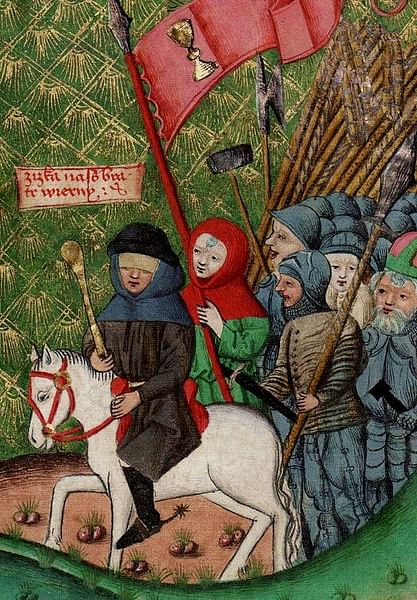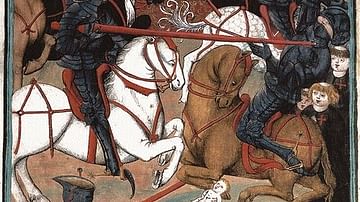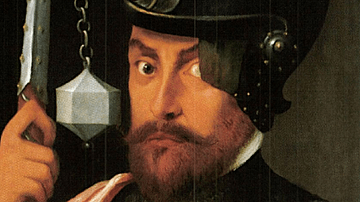
The Bohemian Reformation (c. 1380 to c. 1436) was the first concerted effort by Catholic clergy to reform the abuses and corruption of the medieval Church. Bohemian clerics and theologians called for reform and, like later advocates, initially had no intention of breaking with the Church until the martyrdom of Jan Hus in 1415.
The Bohemian Church had been established by the Eastern Orthodox Church, not the Church of Rome, by the missionaries (and brothers) Saint Cyril and Methodius in 863. At this time, the Eastern and Western churches were still united and cooperated with each other. After establishing Christianity in Bohemia (modern-day Czech Republic), Cyril and Methodius worked with the Church of Rome in organizing and administrating parishes and, in the case of Methodius, trying to navigate the world of a jealous and corrupt Catholic clergy.
The heretical sect of the Waldensians, fleeing persecution in France and Italy, came to the region in the early 13th century and seems to have influenced the development of local parishes, who recognized the difference between the luxury and opulence of the Church and the simplicity and poverty of the heretics. Calls for reformation came from a number of priests and theologians including Konrad von Waldhausen (d. 1369), Jan Milíč (also given as Milicz von Kremsier, d. 1374), Matthias of Janov (also given as Matěj z Janova d. 1394), and Matthew of Kraków (l. c. 1335-1410). The Bible, only available in Latin, was translated into Czech by c. 1360, allowing anyone literate to read it and sparking further questions on church policy and practice.
The most famous reformer was Jan Hus (l. 1369-1415) who was executed by the Church for heresy as was his friend and co-reformer Jerome of Prague (l. 1379-1416) a year later. Their deaths, as well as continued abuses by the Church, sparked the Hussite Wars (1419 to c. 1434) between followers of Hus' vision and Catholic loyalists. The violence was opposed by the great Hussite thinker and writer Petr Chelčický (l. c. 1390 to c. 1460), recognized as one of the most important voices of the Bohemian Reformation.
Although the Catholics won the conflict, the peace agreed on at the Council of Basel in 1436 granted Bohemia freedom of religion. The dates commonly given for the Bohemian Reformation are understood as approximations. The movement began earlier than c. 1380 (when is not known), and although the Basel conference can be considered the conclusion, further conflicts would ensue that were not resolved until the era of the Protestant Reformation (1517-1648) or later.
Bohemian Church & Early Reformers
Cyril and Methodius are celebrated as the founders of the early Bohemian Church owing to their conversion of Duke Bořivoj I of Bohemia to Christianity which influenced his family and the nobility to follow his example. Cyril died in Rome in 869, and Methodius was appointed Archbishop of Moravia and Pannonia, central regions of Great Moravia which included Bohemia. Jealousies among other clergy led to Methodius' arrest in 870 on the grounds that he was preaching and celebrating Mass in the vernacular instead of Latin. After three years in prison, he was released and translated the Bible into Slavonic while continuing to fend off attacks by fellow clergy, until his death in 885.
The Eastern and Western churches continued in cooperation, more or less, until the Great Schism of 1054. By this time, so-called heresies had begun to appear throughout Europe in response to the very clear difference between the figure and teachings of Jesus Christ and the policies and dogma of the Catholic Church. Around 1177, the Waldensian movement was either founded or significantly developed by Peter Waldo (l. c. 1140-1205) of Lyon, France. The Waldensians advocated poverty, simplicity in all things, and service to others while condemning the luxury, policies, and dogma of the Church. They were condemned, persecuted, and fled to Bohemia in the 13th century.
How much influence the Waldensians had on the development of the Bohemian Church is still debated. It is possible their influence was negligible, but this seems unlikely as later reformers touch on many of their points. Still, since those reformers were literate and acquainted with the Bible, it would not be a far reach for them to conclude that the Church they were serving had little in common with the lives and vision of Jesus Christ and his disciples or of Saint Paul and the early Christianity depicted in the biblical Book of Acts.
Konrad von Waldhausen was quite vocal in his denunciation of the Church's corruption and calls for reform but was ignored. Jan Milíč, fluent in both Czech and German, was so popular a preacher that he held service up to five times a day and attracted crowds so large to the Tyn Church in Prague that he frequently had to preach out in the open square. He claimed that the end times were at hand and the antichrist was already among them, personified in the pope.
Milíč was arrested when he traveled to Rome to deliver this news in person but was so popular (and also admired by the Bohemian king and Holy Roman Emperor Charles IV, r. 1355-1378) that he was released. He returned home where he set up a school for preachers who were to spread his vision of a simpler, Bible-based, Christianity. He was summoned by the pope to return to Rome and stand trial for heresy but died before he was scheduled to appear. Matthew of Krakow, a theology professor at the University of Prague, was the central figure in a delegation to Pope Urban VI in 1382 calling for reform, but his suggestions went unheeded, just as earlier attempts had been.
Matthias of Janov was the most prolific writer of these four early reformers who was the first to develop the concept of a True and False church, possibly derived from the works of the English reformer John Wycliffe (l. 1330-1384) or, as with Wycliffe, from the writings of Saint Augustine of Hippo. Matthias of Janov maintained there was an ideal Christianity expressed by Christ and his apostles and a false Christianity expressed in the Church whose pope was the antichrist warned of in the biblical Book of Revelation. It is unclear how deeply these four influenced Jan Hus but, once he read the works of Wycliffe, he would develop many of their claims in calling for reform.
Jan Hus
Jan Hus was the central figure of the Bohemian Reformation as it was his martyrdom in 1415 that radicalized the movement and led directly to the Hussite Wars. Hus was born to the peasant class and learned the scriptures at a young age from his mother who read to him from the Bohemian Bible and encouraged him to enter the priesthood for a better life. He graduated with his Master's in 1396, was teaching at the University of Prague by 1398, and was appointed priest of the Bethlehem Chapel in 1402. The Bethlehem Chapel was founded in 1391 with the proviso that services there would be conducted in Czech, a condition that would influence Hus' ministry.
That same year, he was introduced to the works of John Wycliffe by his friend Jerome of Prague. Jerome had studied at Oxford – where Wycliffe had been a professor – and had copied a number of his works. Hus responded immediately to Wycliffe's condemnation of church policies such as simony (selling or giving church offices to family members and friends who were often unqualified) and the selling of indulgences, writs which were said to shorten one's time, or that of a loved one, in purgatory, among others. The Bethlehem Chapel seated over 3,000 congregants, and Hus preached two sermons every Sunday, articulating his and Wycliffe's criticisms of the Church in the vernacular. As he was a very popular preacher, his views were quickly spread by his audience and, further, by his works, which were printed, also in Czech, using the technique of woodblock printing and distributed.
Hus was called to the Council of Constance (also given as Council of Konstanz) in 1414 to explain his 'errors' and was given a writ of safe passage by Sigismund of Hungary (l. 1368-1437). When he arrived, and before the council convened, he began preaching in Konstanz and was arrested by church officials who claimed this violated his safe passage writ. He was imprisoned, told repeatedly to recant, and finally condemned and burned at the stake as a heretic on 6 July 1415. Jerome of Prague, who defended his views, met the same end a year later.
Hussite Rebellion & Four Articles of Prague
One of the policies of the Church Hus had challenged was the practice of priests, in celebrating the Eucharist, of giving only the bread to the laity and reserving the wine for themselves. Hus advocated for the practice of utraquism ("under both kinds"), which meant both bread and wine would be offered to all Catholics in good standing during Mass. The argument over utraquism would inform the Hussite Rebellion that followed his execution. Scholar John Bossy notes:
The Hussites…stood for the collective salvation of the Czech people by a public repression of sin and a more intense cultivation of the Eucharist, which finally took the form of universal communion in both kinds (utraeque specie). Known for this reason as Utraquists, they were about as radical as Joan of Arc, and their backbone was a pious nobility. (81)
Exactly how pious the nobility was is debated, but they understood that any blow against the power and authority of the Church was good news for them. The Church held title to many profitable lands throughout Europe that could not be taxed, and if a challenge to ecclesiastical power could be proven to offer the same hope of salvation as the Church, this would mean greater power and profit for the nobility. The religious revolt, therefore, also became a political movement which, still, sought to address abuses by the Church hierarchy.

The Hussites articulated their vision in the Four Articles of Prague:
- Freedom to preach the word of God from scripture
- Freedom of the chalice in communion (utraquism)
- Prohibition on clergy owning large estates or serving in positions of secular authority
- Punishment for mortal sins regardless of social standing
Utraquism became a central rallying point for the Hussites because the traditional practice of the clergy holding the wine – considered the blood of Christ – back from the laity epitomized church policy of separating congregants from the essential teachings and meaning of Christ's ministry. The Mass was said in Latin, prayers were taught in Latin, the Bible was read to congregants in Latin, which very few of the laity understood. The clerical control of the Eucharist came to symbolize the repressive policies of the Church in all other matters, propelling utraquism to the center stage of the rebellion that launched the Hussite Wars in 1519. Their symbol, emblazoned on standards, shields, and elsewhere, was the chalice.
The conflict began after the event known as the First Defenestration of Prague on 30 July 1419 when a group of Hussites, enraged at Catholic officials' refusal to surrender Hussite captives, hurled seven members of the city council out of the high windows of the town hall; all seven died from the fall. The news of their deaths quickly shattered any illusion of safety or comfort in Bohemia as Hussites then ransacked Catholic establishments and Catholic loyalists attacked Hussites. Scholar Howard Louthan writes:
Though precise numbers are difficult, if not impossible, to determine, it is clear that the majority of the kingdom [of Bohemia] defected to Utraquism…The running of day-to-day affairs in churches was complicated. The Hussite wars had nearly completely destroyed the kingdom’s ecclesiastical infrastructure. Nearly all church property had been secularized and most monasteries wrecked or shuttered. (Rublack, 133)
Sigismund of Hungary had been granted permission by the pope to launch a crusade to crush the heretical Hussites, which meant the destruction of many towns, villages, and cities as the region erupted in violence. Civilian deaths were common because, in a religious conflict, anyone not on the side of the approaching army was understood as an enemy. Consequently, casualties were high for combatants and non-combatants equally, and many died from starvation or exposure after crops and homes were destroyed.

Jan Žižka & Petr Chelčický
Two men, on the same side, who stood at opposite poles during the conflict were the Hussite general Jan Žižka (l. c. 1360-1424) and the Hussite religious philosopher Petr Chelčický. Although the opponents of the Church are regularly referenced as Hussites, these were actually a diverse group that included a number of factions including the Taborites (centered at Tábor, Bohemia) who coupled the vision of Hus with that of Jan Milíč and preached an end-of-days theology while adhering to the model of early communal Christianity as depicted in the Bible. Jan Žižka of Trocnov was initially a mercenary who had already fought in a number of campaigns and took control of the Taborite forces against Sigismund's crusade.
Žižka had proven himself a capable warrior earlier at the Battle of Grunwald on 15 July 1410 which destroyed the power of the Teutonic Knights but went on from there to lead the Hussite forces successfully against the crusade of Sigismund. He pioneered the use of gunpowder in battle as well as the use of wagon forts in both defensive and offensive tactics. Although he had lost one eye in battle early on and would lose the other later, even blind he was a better general than any of his opponents and was undefeated at the time of his death, from plague, in 1424.
At the other end of the Hussite spectrum was Petr Chelčický who advocated non-violence and adherence to Christ's admonition to love one's enemies and pray for them. Chelčický's view would inform the Unity of the Brethren (also known as the Union of Bohemian Brethren) an important reform movement in the Hussite Wars and afterwards. Louthan comments:
Little is known of Chelcicky's personal background. Of modest means, he was a layman from southern Bohemia who though on friendly terms with many of the Taborites lived apart from them. He was critical of their appeal to the Old Testament with its calls for righteous vengeance and judgment. Chelcicky believed the New Testament had perfected its inferior predecessor. Using the Sermon on the Mount as his guide, he called on Christians to accept the true law of Christ, renounce all claims to power, and refuse the swearing of oaths and the bearing of arms. (135)
Žižka proved the Hussite forces, mainly comprised of farmers and laborers with little to no military experience, equal to the seasoned forces of the Catholic loyalists, while Chelčický, who denounced Žižka violence, provided the spiritual and philosophical basis for the Hussite cause going forward.
Conclusion
The Hussite Wars took a greater toll on the people of Bohemia because, once Žižka had defeated the Catholic forces, the various factions of the Hussites turned on each other. Although every separate Hussite sect could agree on their problems with the Catholic Church, they could not reach any meaningful consensus with each other. At the Battle of Lipany in 1434, moderate Hussites (the Utraquists) aligned themselves with Sigismund's Catholic loyalists to defeat the more radical Hussites (Taborites) and bring the conflict to an end.
At the Council of Basel in 1436, the representatives of the Church recognized the Four Articles of Prague (though the papacy refused to). The Utraquists were granted the freedom to organize their church and conduct services as they saw fit, including, of course, offering both bread and wine to the laity in celebrating the Eucharist. Although they had established themselves as an independent Christian denomination, they continued to look to the Catholic Church for validation and even patterned their own ecclesiastical hierarchy on that of the Church they had fought to free themselves from.
The Utraquist Church of Bohemia elected its own archbishop and established its own hierarchy, even elevating Jan Hus to sainthood and recognizing those who died for the cause as holy martyrs, just as the early Catholic Church had done. After the German Reformation of Martin Luther, and the wider Protestant Reformation that followed, the Utraquists came to be more widely recognized and mainstream. In the present day, their beliefs inform the tenets of the Moravian Church, one of the oldest among the many denominations of Protestant Christianity.








